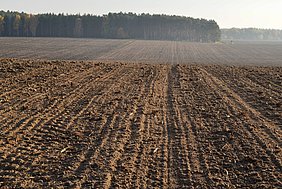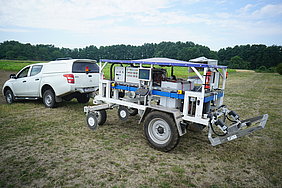5 December is World Soil Day. Soil is essential for human life. ATB is researching in a number of projects to preserve the fertility of the soil. Below we present examples of our manifold research approaches.
World Soil Day was established by the International Union of Soil Sciences (IUSS) at its 17th World Congress in 2002 to raise awareness of the importance of soil as a natural resource.
We take this as an opportunity to draw attention to our own research and planned events in this area.
Save the Date!
27 January 2022: Soil microbial diversity is crucial for plant and planetary health. Expert panel at Global Forum for Food and Agriculture (GFFA).
Informations: https://www.gffa-berlin.de/fachpodien_2022/leibniz-atb/
Soil is essential for human life. It provides the necessary basis for the growth of food for humans and animals. But soil is also important for the ecosystem, as a habitat for microorganisms, plants and animals, for the circulation of nutrients and water, and not least for our climate. This is because the interaction of plants and animals ensures the binding of large amounts of carbon in the soil. Protecting soil as a resource and maintaining or promoting soil fertility is therefore a declared global goal (EEA,2019).
ATB is conducting research in several projects to preserve the fertility of the soil. Here are some examples.
In the I4S project, partners from science, industry and practice are collaborating to develop solutions for maintaining and improving soil fertility in the context of precision agriculture. Soil fertility as the basis for crop yield is characterised by physical, chemical and biological soil properties. But where exactly in the field can which properties be found? Precision agriculture looks at the sometimes considerable spatial variation of soil properties within a field. Tillage, sowing rates, fertilisation and other measures should be adapted to local requirements in the best possible way in order to protect resources and the environment and to optimise yields. In order to obtain detailed soil information, researchers are working to develop, among other things, new soil sensors and mobile sensor platforms for soil mapping. Sensor data and soil process models provide information with high spatial resolution. With information that is easy to interpret, this will provide farmers with a cost-effective method which they can use to control the fertilisation with nutrients such as nitrogen, phosphorus and potassium according to need for almost every square metre of the field. In practice, the system is intended to be largely automated. With the I4S project, the ATB is coordinating one of 10 interdisciplinary joint research projects within the Bonares framework. The project is funded by the BMBF and started in 2015.
Contact ATB: Sebastian Vogel
The EIP funded project "Precise liming in the State of Brandenburg - pH BB" aims to improve the management of soil acidity on farms in Brandenburg, Northeast of Germany. In Brandenburg, 74 % of the areas suffer from reduced yields and deterioration of soil fertility due to pH values that are too high or too low. By using mobile soil sensors, important soil properties can be recorded quickly, cost-effectively and on a small scale. Methods for processing the mapping data and deriving fertiliser recommendations are also being developed. The aim is to find practicable solutions for site-specific fertilisation that facilitate the introduction of precision liming. In addition to the research institutions HNEE (coordination), ATB and IGZ, five practice partners are involved in the pH BB project.
Youtube video pH BB
Contact ATB: Sebastian Vogel
The EIP funded project "Fermentation products to improve livestock housing and soil structure" takes a different approach. Here, the focus is on the utilisation of fermentation residues from biogas plants. Pyrolysis is used to produce biochar on basis of the residues. The char is first used as a bedding additive in dairy barns to reduce emissions and help fix nitrogen and moisture. When applied to the field, the farm manure upgraded with biochar should improve soil fertility and lead to a natural increase in yield.
Contact ATB: Maja Schultze
In the project "Development of methods for deep injection of artificial humic substances against the consequences of climate change - Save a tree in Sanssouci" (funding: MWFK), the water-binding capacity is to be increased by injections of strengthening humic substances into the root area of threatened trees. The active soil microbiom is to be supported and thus the nutrient uptake of the trees is to be improved. Humic substances are produced as a result of the slow decomposition of plant residues by soil animals, fungi and microorganisms. The adsorption and water-holding capacity of these natural organic compounds clearly exceeds that of clay minerals. With the help of a chemical-thermal process, called hydrothermal humification, humic substances can be obtained from residual biomass with a high degree of efficiency while almost completely retaining the carbon bound in the plant material. ATB contributes its expertise in the field of hydrothermal carbonization and the soil microbiome, among other things. Current partners in the project are ATB (coordination), MPIKG, FU Berlin and SPSG. Further information (German)
Contact ATB: Judy Libra and Gabriele Berg
Short-rotation coppice provides climate-friendly fuel in the form of wood chips grown on agricultural land (video on ATB YouTube channel "'Fast' wood from the field for climate-neutral heat"). But what happens in the soil when the land is to be used again to grow for example cereals? In order to quantify relevant influences on the environment and agricultural production after the perennials have been turned over, scientists in the PostKUP project are investigating the carbon sink function within soil, especially in deeper layers (> 30 cm),
Contact ATB: Sonja Germer
Feel free to look for more examples on our webpage under the keywords "Boden" or "soil".


